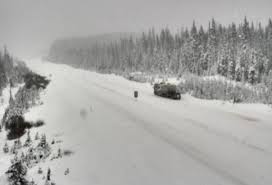Dangerous winter conditions: Environment Canada issues snow and wind advisory for Okanagan Connector

Okanagan Connector
Drivers planning to travel along the Okanagan Connector (Highway 97C) are being urged to use extreme caution as Environment Canada issues a blowing snow advisory for the region. The warning, released early Tuesday morning, cautions motorists that powerful crosswinds and heavy snowfall are expected to create dangerous travel conditions overnight through Wednesday morning.
According to Environment Canada, visibility on parts of the highway — which connects Merritt to Peachland and West Kelowna — could drop to 800 metres or less due to blowing snow. “Travel is expected to be hazardous due to reduced visibility in some locations,” the agency stated in its latest weather bulletin.
A Night of Blowing Snow and Crosswinds
The advisory warns of strong gusty winds sweeping across the high-elevation route, which is particularly vulnerable to blowing snow and drifting. The combined effect of snow and wind will make it difficult for drivers to see the road ahead, increasing the risk of accidents and delays.
Environment Canada defines a blowing snow advisory as a situation where visibility is expected to remain below 800 metres for at least three consecutive hours. In this case, the warning comes as temperatures plunge and early winter weather patterns grip parts of British Columbia’s interior.
“Motorists should be prepared for rapidly changing conditions,” the forecaster advised, noting that mountain weather can shift suddenly without warning.
Safety Recommendations for Drivers
Authorities are urging motorists to adjust their travel plans if possible and to drive with extreme care. If visibility is reduced, drivers are advised to slow down, keep headlights on low beam, watch for taillights ahead, and be ready to stop suddenly.
The Okanagan Connector, which runs through steep mountain passes, is often among the first routes in British Columbia to experience winter driving hazards each year. Officials are reminding travelers that winter tires are mandatory on Southern Interior highways from October 1 through the spring season.
“Even a short section of blowing snow can catch drivers off guard,” the statement emphasized. “Conditions may deteriorate quickly, especially at higher elevations.”
Winter’s Early Grip on B.C.
This latest advisory highlights how early winter weather is already impacting regions across Western Canada. Strong winds and fresh snowfall have been reported in parts of Kamloops, Merritt, and Kelowna, signaling the start of a long and potentially challenging winter season.
Local authorities and maintenance crews are closely monitoring the situation to ensure the roads remain passable, though conditions may remain unpredictable through Wednesday morning.
Travelers are encouraged to check DriveBC or Environment Canada’s weather portal for real-time updates on highway conditions before embarking on their journeys.
FAQ
Q: Where is the blowing snow advisory in effect?
A: The advisory covers the Okanagan Connector (Highway 97C) between Merritt, Peachland, and West Kelowna.
Q: When will conditions be at their worst?
A: Hazardous conditions are expected Tuesday night into Wednesday morning, with strong winds and low visibility.
Q: What should drivers do if visibility drops suddenly?
A: Reduce speed, use low-beam headlights, maintain distance from other vehicles, and prepare to stop when necessary.
Q: Why is this area prone to blowing snow?
A: The Okanagan Connector passes through high mountain terrain where wind and snow combine to reduce visibility rapidly.
Q: Are winter tires mandatory?
A: Yes, winter tires are required on Southern Interior highways as of October 1.

